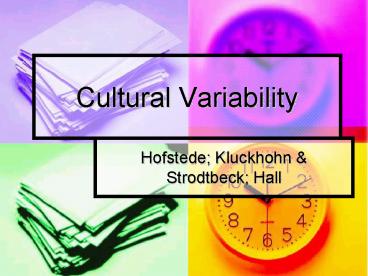Cultural Variability - PowerPoint PPT Presentation
1 / 21
Title:
Cultural Variability
Description:
Individualism-collectivism. Uncertainty avoidance. Power distance ... Individualism-collectivism. All cultures have both individual and collective dispositions ... – PowerPoint PPT presentation
Number of Views:541
Avg rating:3.0/5.0
Title: Cultural Variability
1
Cultural Variability
- Hofstede Kluckhohn Strodtbeck Hall
2
Hofstedes Value Dimensions
- Individualism-collectivism
- Uncertainty avoidance
- Power distance
- Masculinity-feminity
3
Hofstedes Value Dimensions
- Individualism-collectivism
- All cultures have both individual and collective
dispositions - Individualism
- 1.) The individual is the single most important
unit in any social setting - 2.) independence rather than dependence is
stressed - 3.) individual achievement is rewarded
- 4.) The uniqueness of each individual is of
paramount value
4
Hofstedes Value Dimensions
- Individualism-collectivism
- Collectivism We consciousness
- 1.) Characterized by a more rigid social
framework that distinguishes between in-groups
and out-groups - Greater emphasis on the views, needs, and goals
of the in-group rather than one-self - Social norms and duty defined by the in-group
rather than behavior to get pleasure - Beliefs shared with the in-group rather than
beliefs that distinguish self from in-group - Great readiness to cooperate with in-group
members.
5
Hofstedes Value Dimensions
- Uncertainty Avoidance
- The future is unknown
- The extent to which people within a culture are
made nervous by situations which they perceive as
unstructured, unclear, or unpredictable,
situations which they therefore try to avoid by
maintaining strict codes of behavior and a belief
in absolute truths.
6
Hofstedes Value Dimensions
- High-Uncertainty Avoidance
- Try to avoid uncertainty and ambiguity by
providing stability for their members,
establishing more formal rules, not tolerating
deviant ideas and behaviors, seeking consensus,
and believing in absolute truths and the
attainment of expertise.
7
Hofstedes Value Dimensions
- Low-Uncertainty Avoidance
- More easily accept the uncertainty inherent in
life and are not as threatened by deviance,
tolerate the unusual. They prize initiative,
dislike structure associated with hierarchy, are
more wiling to take risks, are more flexible,
think there should be as few rules as possible,
depend less on experts, more on common sense
8
Hofstedes Value Dimensions
- Power Distance
- The extent to which a society prefers that power
in relationships, institutions, and organizations
is distributed unequally.
9
Hofstedes Value Dimensions
- Large-power distance
- Believe that power and authority are facts of
life. Social hierarchy is prevalent importance
placed on status and rank
10
Hofstedes Value Dimensions
- Small-power distance
- Inequality in society should be minimized. The
powerful and the powerless try to live in
concert. - The classroom location to measure power distance
11
Hofstedes Value Dimensions
- Masculinity-Feminity
- The degree to which masculine or feminine traits
are valued and revealed.
12
Hofstedes Value Dimensions
- Masculinity
- The extent to which dominant values in society
are male oriented. These cultures are associated
with such behaviors as ambition, differentiated
sex roles, achievement, the acquisition of money,
and signs of manliness.
13
Hofstedes Value Dimensions
- Femininity
- Stress caring and nurturing behavior. A feminine
world view maintains that people need not be
aggressive and that men and women can assume
nurturing roles it also promotes sexual equality
and holds that people and the environment are
important. Gender roles are more fluid.
Interdependency and androgyny are the ideal.
14
Kluckhohns Strodtbecks Value Orientations
- All people turn to their culture to answer the
same basic questions. - What is the character of human nature
- What is the relationship of humankind to nature?
- What is the orientation toward time?
- What is the value placed on activity?
- What is the relationship of people to each other?
15
Kluckhohns Strodtbecks Value Orientations
16
Halls Culture orientations
- High-Context Low-Context
- Monochronic Polychronic Time
17
Halls Culture Orientations
- Context (high or low)
- The degree to which meaning comes from the
settings or from the message being exchanged.
18
Halls Culture Orientations
- High Context
- The meaning is in the situation (context).
- For most normal transactions in daily life these
culture do not require, nor do they expect, much
in-depth, background actions in daily life they
do not require, nor do they expect, much in-depth
background infromation. Its not necessary to
verbalize everything. - Implicit indirect
19
Halls Culture orientations
- Less homogeneous populations
- Each time others interact they need detailed
background information - Meaning is in the message
- Explicit direct
20
Halls Culture orientations
- Monochronic time
- Urges people to do one thing at a time. Time is
like a long ribbon of highway that can be sliced
into segments. Have a high need for
closurecompleting a task or coming to a
conclusion before beginning something else
21
Halls Culture orientations
- Polychronic time
- Members think in terms of pictures or
configurations nonlinear orientation to time
think about and attempt to do many things
simultaneously.

